Today’s installation of Making Cycling Difficult, is a How to Guide on ruining an otherwise perfect ride, and in extension, a perfectly beautiful day.
If you really want to make cycling difficult, sometimes it takes some preparation. I suggest that you start the night before. Remember, nobody likes a procrastinator. So check your forecast. If you see that a day that you have off from work is going to be amazingly beautiful, the night before that day you start to party.
Now everything is best in moderation, so it goes to be moderate with your moderation and have a good time. Even better, if you can fit 2-3 parties into the night, better yet. It is also advised that on this night of ruckous behaviour, you should stay up at least five hours later than you normally do. This just adds to the difficulty. You may say that lack of sleep is over the top. Well, my response to that is, do you wanna live your entire life doing things half-ass? Didn’t think so.
Now that the night is passed and morning is upon us breaking with a bright, shiny sun, you have to make sure that you have the fortitude to stay the course. Many a lesser human being, when presented with the task you have taken upon yourself would shrink back into bed not to emerge until the next day. But nay, you must drag yourself out and start to learn to balance with the cobwebs weighing down your thought processes. This essential to actually being able to ride your bike which happens to be impossible when stuck on your backside in bed.
The next steps are easy and tend to fall into place once you have made the effort the night before, but in the interest of providing a complete guide I will enumerate them for you.
1. Remove your cycling shoes from the car. If you really want to go over the top, make sure the shoes you do wear to the trailhead have an extremely soft sole.
2. Plan a ride that consists of driving for about 1 hour and about 45 minutes of actually riding.
3. When leaving the trailhead, leave your water in the car. You are already dehydrated why try to change that now…
The key to all of this is really making sure that none of your riding buddies know what is going on because they will try in every way to keep you from ruining your ride. A lot of, “Oh Shit! I left my shoes at home.” and, “Well, kids I left my water in the car, I guess I better turn around at the shortcut.” These phrases are necessary to keep them off your back. Even though you in fact are going to ride the whole damn trail with every pedal stroke of pain.
This is how, if you follow the plan correctly, it should look.
In closing, I would recommend that you don’t take your own camera on such an effort like this one, so it is necessary to steal the photos from someone else just like I have done here. I also suggest giving credit where credit is due. All photos were “borrowed” from Fixie Dave. If you would like to see more of him, go here.
If you have any questions, please hesitate to ask.
As a reminder, we will be doing another night ride this Wednesday at 9 pm. Meet at the Navajo trailhead. We will do some sort of conglomeration of Stucki and the Poppy trail with connectors added as needed.
P. L. and R.




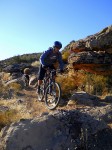
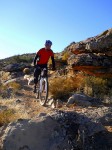
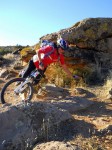
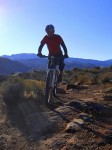
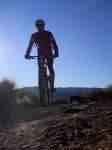
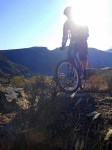
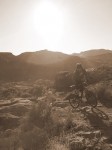
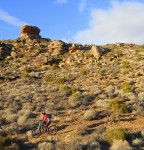
This trip is rated Moderate Plus [3-4] and consists of a combination of moderate and more vigorous cycling days covering 35-40 miles over predominantly hilly terrain with some long, steep uphill climbs. Daily rides have total elevation gains and losses ranging from ~1,600′-3,500′ with hill grades averaging 4-8% with short pitches up to 15%. Vehicle support is available when needed. All participants should have cycling experience that includes maintaining control of the bike, shifting gears, braking, ascending hills, descending hills, cornering, riding in groups, riding with traffic, and knowledge of bicycle safety, in addition to being comfortable in the saddle for 4-6 hours per day. While the majority of the cycling route is on a paved surface, the pavement may be uneven, potholed, or topped with gravel or other debris. Additionally, the inclement weather may affect any riding surface causing additional debris or the surface to become slick. All participants should be comfortable riding on a variety of surfaces in addition to paved roads such as cobblestone streets, as well as city streets with vehicle traffic, and country back roads.